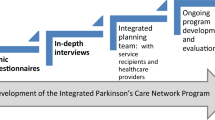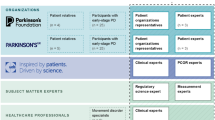Abstract
Background
Focusing clinical investigations on outcomes that are meaningful from an end-user perspective is central in clinical research, particularly in chronic disorders such as Parkinson’s disease (PD). However, little is known about how end-users such as people with PD (PwPD) and health care professionals (HCPs) view and prioritize therapeutic outcomes.
Purpose
To compare the perspectives of PwPD and HCPs regarding prioritized areas for outcome measurement in clinical PD trials.
Methods
Concept mapping was used to identify prioritized outcomes (statements) through focus groups (n = 27; 12 PwPD, 12 HCPs, three researchers), statement sorting and importance rating (n = 38; 19 PwPD, 19 HCPs), followed by quantitative (multidimensional scaling, cluster analysis, procrustes analysis) and qualitative analysis.
Results
Sorting of 99 statements by PwPD and HCPs yielded 2D maps (PwPD/HCPs stress values, 0.31/0.21) with eight clusters per group. The correlation between raw sorting data of PwPD and HCPs was 0.80, and there was a significant concordance (m 12 = 0.53; P < 0.001; i.e., r = 0.68) between the spatial arrangements in their respective maps. Qualitatively, the maps from the two groups represented partially different perspectives. There were no significant differences between PwPD and HCP item importance ratings.
Conclusion
Although similarities dominated, there were differences in how the relationships between items were perceived by the two groups, emanating from different perspectives, i.e., the clinical biomedical (“disease”) versus the lived experience (“illness”). This study illustrates the clinical importance of attention to the perspective of PwPD; taking this into account is likely to provide evidence from clinical investigations that are meaningful and interpretable for end-users.



Similar content being viewed by others
References
Jankovic, J. (2008). Parkinson’s disease: Clinical features and diagnosis. Journal of Neurology, Neurosurgery and Psychiatry, 79(4), 368–376.
Chaudhuri, K. R., & Odin, P. (2010). The challenge of non-motor symptoms in Parkinson’s disease. Progress in Brain Research, 184, 325–341.
Mayer, M. (2012). Seeking what matters: Patients as research partners. Patient, 5(2), 71–74.
Staniszewska, S., Haywood, K. L., Brett, J., & Tutton, L. (2012). Patient and public involvement in patient-reported outcome measures: Evolution not revolution. Patient, 5(2), 79–87. doi:10.2165/11597150-000000000-00000.
World Health Organization, and World Bank. (2011). World report on disability. Geneva: World Health Organization.
Holmes, D. (2011). Patients have their say on research priorities. Lancet Neurology, 10(10), 874–875. doi:10.1016/S1474-4422(11)70219-8.
Chalmers, I. (2007). The Alzheimer’s Society, drug firms, and public trust. British Medical Journal, 335, 400.
EU Joint Programme—Neurodegenerative Disease Research. (2012). JPND research strategy—Tackling the challenge of Alzheimer’s and other neurodegenerative diseases in Europe. UK Medical Research Council. Available from: http://www.neurodegenerationresearch.eu/fileadmin/Documents/2012/SRA-related/JPND_brochure_final_Hyperlink_2012.pdf. Accessed 30 Dec 2013.
Nisenzon, A. N., Robinson, M. E., Bowers, D., Banou, E., Malaty, I., & Okun, M. S. (2011). Measurement of patient-centered outcomes in Parkinson’s disease: What do patients really want from their treatment? Parkinsonism & Related Disorders, 17(2), 89–94.
Sjodahl Hammarlund, C., Hagell, P., & Nilsson, M. H. (2012). Motor and non-motor predictors of illness-related distress in Parkinson’s disease. Parkinsonism & Related Disorders, 18(3), 299–302. doi:10.1016/j.parkreldis.2011.10.015.
Sjodahl Hammarlund, C., Nilsson, M. H., & Hagell, P. (2012). Measuring outcomes in Parkinson’s disease: A multi-perspective concept mapping study. Quality of Life Research, 21(3), 453–463. doi:10.1007/s11136-011-9995-3.
Kane, M., & Trochim, W. M. K. (2007). Concept mapping for planning and evaluation. Thousand Oaks: Sage.
Trochim, W. M. K. (1989). An introduction to concept mapping for planning and evaluation. Evaluation and Program Planning, 12(1), 1–16.
Hoehn, M. M., & Yahr, M. D. (1967). Parkinsonism: Onset, progression and mortality. Neurology, 17(5), 427–442.
Sturrock, K., & Rocha, J. (2000). A multidimensional scaling stress evaluation table. Field Methods, 12(1), 49–60.
Rosas, S. R., & Kane, M. (2012). Quality and rigor of the concept mapping methodology: A pooled study analysis. Evaluation and Program Planning, 35(2), 236–245.
Trochim, W. M. K. (1993). The reliability of concept mapping. In Paper presented at the annual conference of the American Evaluation Association, Dallas, TX, November 6, 1993.
Stillman, F. A., Schmitt, C. L., & Rosas, S. R. (2012). Opportunity for collaboration: A conceptual model of success in tobacco control and cancer prevention. Preventing Chronic Disease, 9, E02.
Jackson, D. A. (1995). PROTEST: A PROcrustean randomization TEST of community environment concordance. Ecoscience, 2(3), 297–303.
Peres-Neto, P. R., & Jackson, D. A. (2001). How well do multivariate data sets match? The advantages of a Procrustean superimposition approach over the Mantel test. Oecologia, 129, 169–178.
Schneider, J. W., & Borlund, P. (2007). Matrix comparison, part 2: Measuring the resemblance between proximity measures or ordination results by use of the Mantel and Procrustes statistics. Journal of the American Society for Information Science and Technology, 58(11), 1596–1609.
Eisenberg, L. (1977). Disease and illness. Distinctions between professional and popular ideas of sickness. Culture, Medicine and Psychiatry, 1(1), 9–23.
Helman, C. G. (1981). Disease versus illness in general practice. Journal of the Royal College of General Practitioners, 31(230), 548–552.
Hobart, J., & Cano, S. (2009). Improving the evaluation of therapeutic interventions in multiple sclerosis: The role of new psychometric methods. Health Technology Assessment, 13(12), iii, ix–x, 1–177.
Hobart, J., Cano, S., Baron, R., Thompson, A., Schwid, S., Zajicek, J., et al. (2013). Achieving valid patient-reported outcomes measurement: A lesson from fatigue in multiple sclerosis. Multiple Sclerosis, 19(13), 1773–1783. doi:10.1177/1352458513483378.
Antonini, A., Martinez-Martin, P., Chaudhuri, R. K., Merello, M., Hauser, R., Katzenschlager, R., et al. (2011). Wearing-off scales in Parkinson’s disease: Critique and recommendations. Movement Disorders, 26(12), 2169–2175.
Den Oudsten, B. L., Van Heck, G. L., & De Vries, J. (2007). The suitability of patient-based measures in the field of Parkinson’s disease: A systematic review. Movement Disorders, 22(10), 1390–1401.
Hogl, B., Arnulf, I., Comella, C., Ferreira, J., Iranzo, A., Tilley, B., et al. (2010). Scales to assess sleep impairment in Parkinson’s disease: Critique and recommendations. Movement Disorders, 25(16), 2704–2716.
Schrag, A., Barone, P., Brown, R. G., Leentjens, A. F., McDonald, W. M., Starkstein, S., et al. (2007). Depression rating scales in Parkinson’s disease: Critique and recommendations. Movement Disorders, 22(8), 1077–1092.
Tomlinson, C. L., Patel, S., Meek, C., Herd, C. P., Clarke, C. E., Stowe, R., et al. (2012). Physiotherapy intervention in Parkinson’s disease: Systematic review and meta-analysis. British Medical Journal, 345, e5004.
Tyson, S., & Connell, L. (2009). The psychometric properties and clinical utility of measures of walking and mobility in neurological conditions: A systematic review. Clinical Rehabilitation, 23(11), 1018–1033.
Brown, C. A., Cheng, E. M., Hays, R. D., Vassar, S. D., & Vickrey, B. G. (2009). SF-36 includes less Parkinson’s disease (PD)-targeted content but is more responsive to change than two PD-targeted health-related quality of life measures. Quality of Life Research, 18(9), 1219–1237.
Hagell, P., & Nilsson, M. H. (2009). The 39-item Parkinson’s disease questionnaire (PDQ-39): Is it a unidimensional Construct? Therapeutic Advances in Neurological Disorders, 2(4), 205–214. doi:10.1177/1756285609103726.
Hagell, P., & Nygren, C. (2007). The 39 item Parkinson’s disease questionnaire (PDQ-39) revisited: Implications for evidence based medicine. Journal of Neurology, Neurosurgery and Psychiatry, 78(11), 1191–1198.
Hagell, P., Reimer, J., & Nyberg, P. (2009). Whose quality of life? Ethical implications in patient-reported health outcome measurement. Value in Health, 12(4), 613–617. doi:10.1111/j.1524-4733.2008.00488.x.
Lee, M. A., Walker, R. W., Hildreth, A. J., & Prentice, W. M. (2006). Individualized assessment of quality of life in idiopathic Parkinson’s disease. Movement Disorders, 21(11), 1929–1934.
Hobart, J. C., Cano, S. J., Zajicek, J. P., & Thompson, A. J. (2007). Rating scales as outcome measures for clinical trials in neurology: Problems, solutions, and recommendations. Lancet Neurology, 6(12), 1094–1105.
Wilson, M. (2005). Constructing measures: An item response modelling approach. Mahwah, NJ: Lawrence Erlbaum.
Acknowledgments
The authors wish to thank all participants for their cooperation, and J. Reimer, S. Lindskov and K. Wictorin for assistance in recruiting participants. The study was conducted within BAGADILICO (the Basal Ganglia Disorders Linnaeus Consortium) at Lund University, Sweden. The study was supported by the Swedish Research Council, the Swedish Parkinson Academy, the Faculty of Medicine at Lund University, Lund, Sweden, and the School of Health and Society, Kristianstad University, Kristianstad, Sweden. MHN was partly funded by the Strategic Research Area MultiPark at Lund University, and by the Swedish Council for Working Life and Social Research within the context of the Centre for Ageing and Supportive Environments (CASE), Lund University, Sweden.
Author information
Authors and Affiliations
Corresponding author
Rights and permissions
About this article
Cite this article
Sjödahl Hammarlund, C., Nilsson, M.H., Idvall, M. et al. Conceptualizing and prioritizing clinical trial outcomes from the perspectives of people with Parkinson’s disease versus health care professionals: a concept mapping study. Qual Life Res 23, 1687–1700 (2014). https://doi.org/10.1007/s11136-013-0614-3
Accepted:
Published:
Issue Date:
DOI: https://doi.org/10.1007/s11136-013-0614-3




